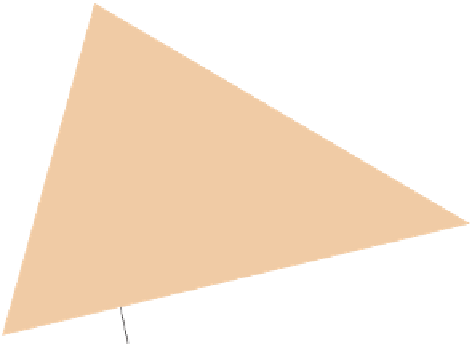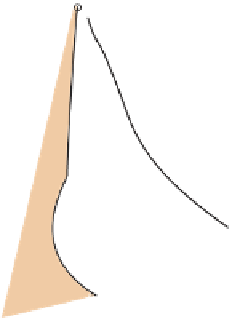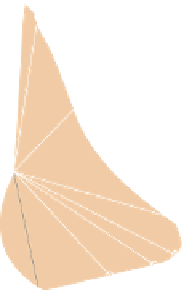Graphics Reference
In-Depth Information
430
480
800
600
505
0
200
400
530
5
5
5
580
400
605
200
M
600
0
800
0
100
200
300
400
500
600
1,000
700
800
900
L
1,000
Figure 28.12: The set of all possible responses from combinations of monospectral lights
(i.e., all possible spectral power distributions) forms a generalized cone in the space of
response triples. The cone's intersection with the S
+
M
+
L
=
1000
plane (tan) is the area
bounded by the aqua curve.
shape of this curve might be if the sensors' response curves were different, and
where the monospectral curve would lie in those cases.)
Knowing how spectral information is converted to perceive color (at least in the
absence of gestalt influences) allows us to understand something about the con-
ventional wisdom surrounding color. We'll discuss a few common claims here.
We often hear that “red, green, and blue are primary colors” (usually without a
definition of “primary”), which we take to mean that they are colors that cannot
be made from others, while all other colors
can
be made from them. Anyone who
has tried to make orange from red, green, and blue paint knows this is false. But
you
can
create a wide range of colors (or, to be pedantic, of paints which, when
illuminated by sunlight or similar spectra, produce a wide range of color percepts)
from red, green, and blue—far wider than you can produce from pink, yellow, and
orange, for instance.
If we consider the aqua curve in Figure 28.12, but we adjust each monospectral
light using the luminous efficiency curve so that they all have the same perceptual
brightness, we get a curve in the plane of constant brightness that looks some-
thing like Figure 28.13 and on which we can identify points corresponding to the
percepts “red,” “green,” and “blue.” The responses associated to other spectral
power distributions of the same brightness fill in this horseshoe shape, resulting in
other percepts of “less saturated” colors, including white near the center.
The triangle generated by the colors red, green, and blue occupies much of
this horseshoe shape, partially justifying calling them “primary,” although this
corresponds to the addition of lights (i.e., we can say that red, green, and blue are
primary light colors).











































































